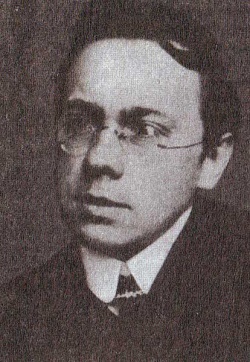Voldemārs Matvejs
 Matvejs in 1912. | |
| Born |
October 13, 1877 Riga, Latvia |
|---|---|
| Died |
May 16, 1914 (aged 36) St. Petersburg, Russia |
Also Vladimir Ivanovich Markov; Voldemar Janovič Matvej; Hans Waldemars Yanov Matvejs; Valdemars Matvejs. Latvian artist and art theorist, active in Russia.
Contents
Born 1877 in Riga. Trained at the Riga art school of Benjamin Blum (1861–1949) before moving to St Petersburg, attending the private studio of I. Tsionglinsky and entering the Academy of Arts in 1906 (until 1914). [1]
As the principal spokesman for the St Petersburg art society, the Union of Youth (1910–14), Matvejs published articles defending the group’s artistic experiments, organized its early exhibitions and travelled to western Europe to establish links with the German and French avant-garde (Walden, Kandinsky, Marc). [2]
Matvejs spent on these travels every summer from 1910 to 1913 and he also used them as an opportunity to study medieval art, Negro art (sculpture), and French modernism. In 1909 he visited the Swedish island of Gotland and was fascinated by the medieval city of Visby and the Early Gothic sculptures there. In 1911 he travelled throughout Italy. In 1912 he was in Paris, Berlin and Cologne. The Union of Youth partly subsidised Matvejs' journeys in Europe in the summers of 1912 and 1913. The 1913 journey was especially important for the development of his theoretical essays. Together with his close friend Varvara Bubnova he visited different collections of the ethnographic museums in Germany, Denmark, Norway, The Netherlands, France and Britain. In museums he made notes and took photographs. [3]
In 1910 his programme for the re-examination of the formal principles of art was manifested in two Union of Youth exhibitions in St Petersburg (K.Petrov-Vodkin, N.Goncharova, M.Larionov, D.Burljuk, I.Mashkov) and Riga and in his article "Russian Secession" [4]. He explored the move from Symbolist-Impressionism to Neo-primitivism and the overlap between them, and indicated the continuing emphasis on spiritual content in Russian art combined with the call for a new social and cultural awareness. [5]
In 1912 he took 'Vladimir Markov' as his nom de plume. His article "Principles of the New Art" [Принципы нового искусства] (1912) and his book Creative Principles in the Plastic Arts: Faktura [Принципы творчества в пластических искусствах: Фактура] (1914) recommend an intuitive, subjective approach to art invoked through empathy and altered states of consciousness. Such a position provided a theoretical basis for the new developments in the art of Malevich, Filonov, Rozanova and Larionov (Cubo-Futurism, analytical art and Rayism), as well as the zaum ('transrational') aesthetic promoted by Kruchenykh. Matvejs' last essays—which included analyses of Chinese poetry ("Chinese Pipe", 1914), Easter island sculpture ("The Art of the Easter Island", 1914) and African art ("Negro Art", 1919)—were grounded in his attempt to redefine the principles of beauty and to re-establish the essential relationship, lost in the alienated world of the Russian art establishment, between modern artists and the world they perceived and experienced; here he concentrated more on plastic and literary principles, analysing creative form from the viewpoint of material conditions and the artist’s psyche. [6]
Matvejs died suddently of peritonitis in 1914 in St Petersburg and was buried in Riga.
Literature
- By Matvejs
- "Printsipy novogo iskusstva" [Принципы нового искусства; Principles of the New Art], 1912.
- Faktura: Printsipy tvorchestva v plasticheskikh iskusstvakh [Фактура: Принципы творчества в пластических искусствах], St. Petersburg: Union of Youth, 1914, 70 pp. (in Russian)
- "Texture Material", trans. Maria Laakso.
- "Chinese Pipe", 1914.
- "The Art of the Easter Island", 1914.
- "Negro Art", 1919.
- The Art of Northern Asia, unfinished.
- On Matvejs
- Margit Rowell, "Vladimir Tatlin: Form/Faktura", October 7 (Winter 1978), pp 83-108.
- Benjamin H. D. Buchloh, "Faktura to Factography", October, Vol. 30 (Autumn 1984), pp 82-119.
- Irēna Bužinska, "Nākotnes mākslu meklējot: Voldemārs Matvejs ārpuseiropas kultūru pētniecības un 20. gs. sākuma zinātnes atklājumu krustceļos" [In Search of a New Art: Voldemārs Matvejs at the Crossroads of Exploring Non-European Culture and Scientific discoveries in the Early 20th Century], Art History and Theory 13, 2010. (in Latvian) [7]